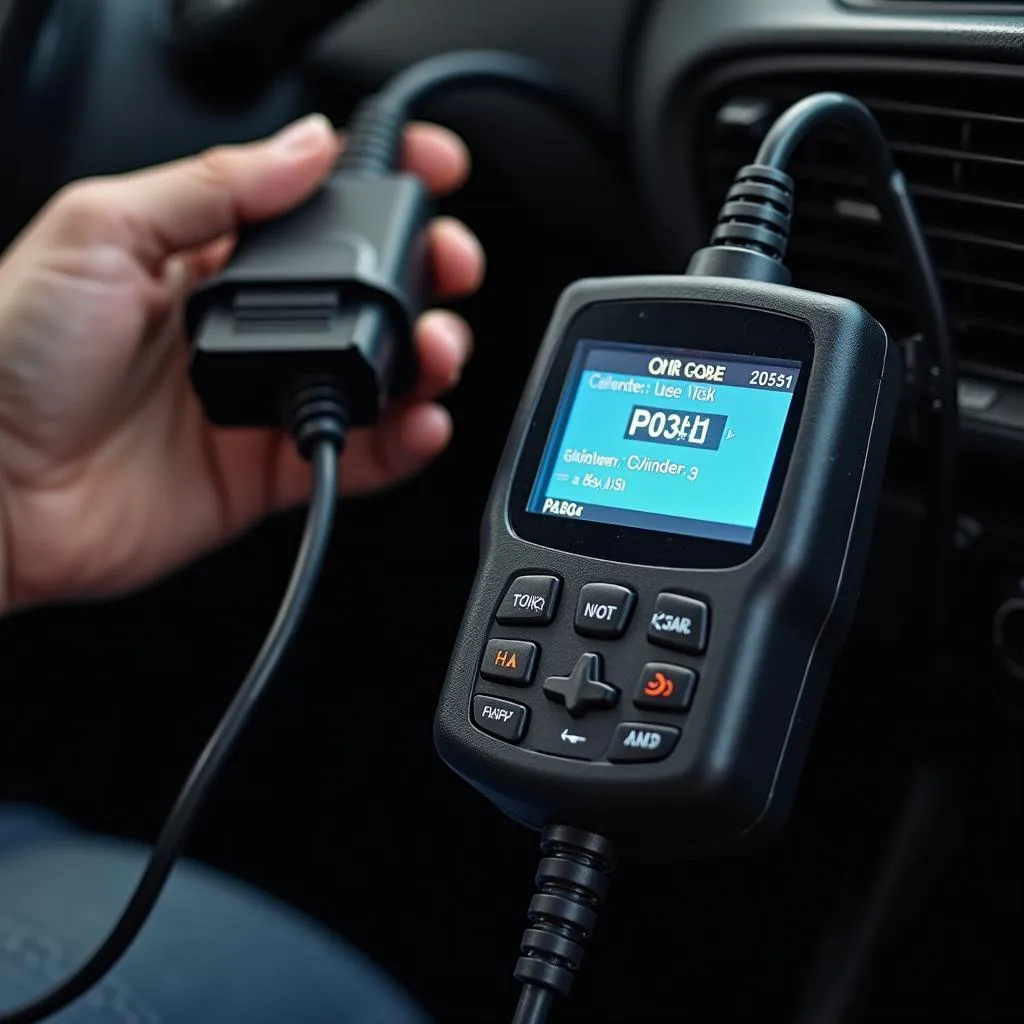One of the most unsettling experiences for a driver is feeling their engine misfire. Not only does it significantly impact your car’s performance, but it can also be a sign of a serious underlying problem. If your OBD2 scanner is flashing the dreaded P0303 code, it’s signaling a misfire in cylinder 3. This article will delve into the intricacies of the P0303 code, its common causes, and the steps you can take to rectify the issue.
Understanding OBD2 Code P0303
In essence, the P0303 code means that your engine’s computer has detected a misfire in cylinder 3. A misfire occurs when the air-fuel mixture in the cylinder fails to ignite properly, or the combustion process is incomplete. This can be due to a variety of reasons, ranging from faulty spark plugs to issues with fuel delivery or even compression problems.
Ignoring this code can lead to more severe engine damage and costly repairs down the line. Therefore, it’s crucial to address the issue promptly.
What Causes a P0303 Code?
A multitude of factors can trigger the P0303 code. Here are some of the most common culprits:
-
Worn-out Spark Plugs: Spark plugs are responsible for igniting the air-fuel mixture in the cylinders. Over time, they can wear down, leading to weak sparks or no spark at all.
-
Faulty Ignition Coils: Ignition coils provide the high voltage necessary for the spark plugs to fire. A failing ignition coil can disrupt the spark, resulting in a misfire.
-
Vacuum Leaks: Vacuum leaks in the intake manifold or hoses can disrupt the air-fuel ratio, making it difficult for the mixture to ignite properly.
-
Fuel Injector Problems: Fuel injectors are responsible for delivering the precise amount of fuel to each cylinder. A clogged or malfunctioning injector can disrupt the fuel supply, leading to a misfire.
-
Compression Issues: Proper compression in the cylinder is crucial for efficient combustion. Worn piston rings, damaged valves, or a blown head gasket can lead to compression loss and misfires.
-
Faulty Wiring or Connectors: Damaged wiring or loose connections in the ignition system can disrupt the flow of electricity, affecting spark plug performance.
Diagnosing the P0303 Code
Diagnosing the root cause of a P0303 code requires a systematic approach. Here’s a step-by-step guide to help you pinpoint the problem:
-
Check for Other Codes: Often, the P0303 code may appear alongside other codes that provide further clues. For example, a P0300 code indicates random misfires, while a P0203 code suggests an issue with the fuel injector circuit in cylinder 3.
-
Inspect the Spark Plugs: Begin by examining the spark plug in cylinder 3. Look for signs of wear, damage, or fouling. If the spark plug appears worn, replace all spark plugs as a general maintenance practice.
-
Inspect the Ignition Coil: Next, inspect the ignition coil connected to cylinder 3. Check for cracks, damage, or loose connections. Consider swapping the ignition coil with another cylinder to see if the misfire follows the coil.
-
Check for Vacuum Leaks: Listen for any hissing sounds coming from the engine bay, which could indicate a vacuum leak. Inspect vacuum hoses for cracks, splits, or loose connections.
-
Inspect Fuel Injectors: While visually inspecting fuel injectors can be challenging, you can check for proper operation by listening for their clicking sound during engine operation. Consider having the fuel injectors professionally tested if you suspect an issue.
-
Compression Test: A compression test can determine if there are any compression issues in cylinder 3. This test requires specialized tools and is best performed by a qualified mechanic.
Fixing the P0303 Code
Once you’ve identified the root cause of the P0303 code, you can proceed with the necessary repairs. Here are some potential solutions:
-
Replace Spark Plugs: If the spark plugs are worn or damaged, replace them with new ones of the recommended type and gap.
-
Replace Ignition Coils: If you suspect a faulty ignition coil, replace it with a new one. It’s often recommended to replace all ignition coils simultaneously to ensure consistent performance.
-
Repair Vacuum Leaks: Seal any vacuum leaks you find using appropriate sealant or by replacing damaged hoses.
-
Clean or Replace Fuel Injectors: Clogged fuel injectors can often be cleaned using a fuel injector cleaning kit. However, severely clogged or malfunctioning injectors may need replacement.
-
Address Compression Issues: Fixing compression issues often involves more extensive repairs, such as replacing piston rings, repairing valves, or even rebuilding the engine. Consult a qualified mechanic for these repairs.
Conclusion
Encountering an OBD2 code P0303 can be concerning, but it’s essential to remember that a proactive approach can save you from costly repairs and engine damage down the line. By understanding the code, its common causes, and the diagnostic steps outlined in this article, you can effectively address the issue and get your car running smoothly again.
However, it’s crucial to acknowledge that diagnosing and repairing engine problems often require specialized tools and knowledge. If you’re unsure about any step in the process or lack the necessary tools, don’t hesitate to seek assistance from a qualified mechanic. They can provide expert diagnosis and ensure your car receives the appropriate repairs.

